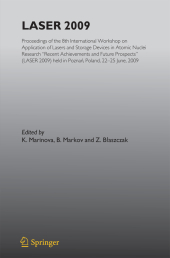 Neuerscheinungen 2014Stand: 2020-02-01 |
Schnellsuche
ISBN/Stichwort/Autor
|
Herderstraße 10
10625 Berlin
Tel.: 030 315 714 16
Fax 030 315 714 14
info@buchspektrum.de |

Z. Blaszczak, K. Marinova, B. Markov
(Beteiligte)
Laser 2009
Proceedings of the 8th International Workshop on Application of Lasers and Storage Devices in Atomic Nuclei Research: Recent Achievements and Future Prospects (LASER 2009) held in Poznan, Poland, 22 June
Herausgegeben von Blaszczak, Z.; Markov, B.; Marinova, K.
2010. 2014. ix, 337 S. 235 mm
Verlag/Jahr: SPRINGER, BERLIN; SPRINGER BERLIN HEIDELBERG 2014
ISBN: 3-642-43624-2 (3642436242)
Neue ISBN: 978-3-642-43624-6 (9783642436246)
Preis und Lieferzeit: Bitte klicken
For most elements of the periodic table, reliable computations of atomic data and properties are still a challenge for (atomic) theory today. Despite of the great effort, that has been undertaken by many groups worldwide during the past four decades, yet serious difficulties arise not only from the complexity of most atoms and ions but also from the large variety of data that is needed in different fields of physics and science. In practice, one often faces several intricacies in performing such computations with the largest, perhaps, (1) due to the shell structure of most atoms and ions. This shell structure, i. e. the occupation of the atomic subshells, does not only change typically when an atom undergoes some transition but also hampers the analysis of one and the same property between neighboured elements. In fact, the particular shell structure of an atom or ion strongly affects the number of degenerate levels (or those nearby in energy) and may thus lead to very different computational requirements in dependence of the occupation of the shells. Further difficulties arise in addition also from (2) the relativistic treatment on the basis of the Dirac-Coulomb (-Breit) Hamiltonian (which is needed for most medium and heavy elements, and sometimes even for the light ones) as well as from (3) the fact that many atomic properties are accompanied by the capture or emission of free electrons.
Preface.- Searching the absolute neutrino mass in tritium ?-decay-interplay between nuclear, atomic and molecular physics.- Isotope shift calculations for open-shell atoms and ions: an extension to the RATIP program.- Nuclear structure effects in the isotope shift with halo nuclei.- Precision laser spectroscopy of Be isotopes and prospects for SLOWRI facility at RIKEN.- Laser spectroscopy in the island of inversion.- Techniques of laser spectroscopy in investigations of lanthanides´ free atoms and ions.- In-source resonance ionization spectroscopy of high lying energy levels in atomic uranium.- Towards high precision in-trap laser spectroscopy of highly charged ions.- Precision laser spectroscopy without optical detection.- Hyperfine splitting constants in the optical transition isotopes and hyperfine anomaly.- Resonant recombination at ion storage rings: a conceptual alternative for isotope shift and hyperfine studies.- The ISOLDE RILIS pump laser upgrade and the LARIS Laboratory.- Status of the LASER-IGISOL collaboration at the University of Jyväskylä.- The selective and efficient laser ion source and trap project LIST for on-line production of exotic nuclides.- Grating tuned Ti:Sa laser for in-source spectroscopy of Rydberg and autoionizing states.- Development of laser ablation assisted resonant ionization mass spectrometry for isotope analysis.- Towards sympathetic cooling of trapped ions with laser-cooled Mg?+? ions for mass spectrometry and laser spectroscopy.- Laser spectroscopy of exotic RI atoms in superfluid helium-OROCHI experiment.- ISOLTRAP results 2006-2009.- Report on recent activities at the CPT mass spectrometer.- Progress of precision measurements at JYFLTRAP.- Recent high-precision Penning trap mass measurements performed at LEBIT.- Report on recent activities at the TITAN mass spectrometer at ISAC/TRIUMF.- Penning trap mass measurements of transfermium elements with SHIPTRAP.- Progress in the applicability of plasma X-ray lasers.- Precise laser spectroscopy of antiprotonic helium at CERN´s Antiproton Decelerator.- Production and investigations of negative osmium ions for fundamental applications: REOSTRAP.- Radium ion: a candidate for measuring atomic parity violation.- Laboratory spectroscopy and the search for variation of the fine-structure constant.- Application of the mass-spectrometer MASHA for mass-spectrometry and laser-spectroscopy.- Development of the collinear laser beam line at TRIUMF.- Atomic physics techniques for studying nuclear ground state properties, fundamental interactions and symmetries: status and perspectives.


